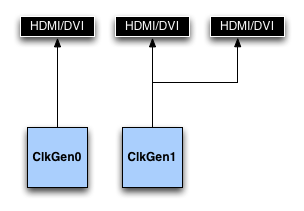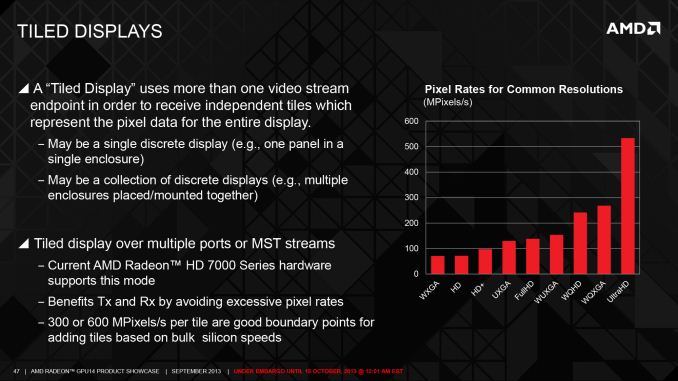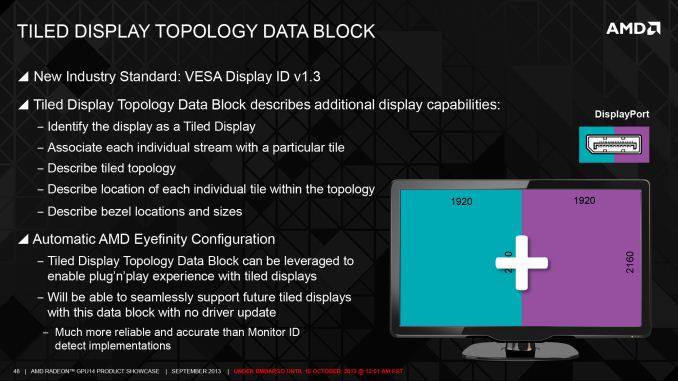The Radeon R9 280X Review: Feat. Asus & XFX - Meet The Radeon 200 Series
by Ryan Smith on October 8, 2013 12:01 AM ESTAMD Display Technologies: 3x DVI/HDMI Out, Tiled Display Support, & More
Although AMD doesn’t have new GPUs to show off today, that doesn’t mean their various hardware groups have been sitting by idle. Even with their existing hardware AMD can make at least some small changes via firmware and drivers, and this is something AMD’s Display Technology group, led by AMD Fellow David Glen, has been working on for the 200 series.
There won’t be any HDMI 2.0 support here (sorry guys, that needs new hardware) but they’ve been working on making improvements to Eyefinity surround setups. As is well known about the 7000 series, it was limited to 2 independent TMDS interface (DVI/HDMI) displays at once. Unlike the packet based DisplayPort interface, which operates at a single clockspeed and can vary the number of packets sent to adjust the resulting bandwidth, TMDS style interfaces adjust the clockspeed of the interface itself to match the needs of the display. As a result while you can drive a large number of DisplayPort interface monitors off of a single shared clock generator, you need a dedicated clock generator for each and every TMDS interface monitor. AMD only put 2 clock generators for TMDS interfaces on their silicon, hence they could only drive 2 such monitors at once.

Radeon 7000 Series DVI/HDMI Output Options: 3, Choose 2
With the 200 series this isn’t changing – it’s the same silicon after all – but AMD has implemented some new tricks to partially mitigate the issue. Thanks to some firmware and board level changes, with the 200 series AMD is now able to attach multiple TMDS transmitters/interfaces to the same clock generator, allowing one clock generator to be used to drive multiple displays. As a result it’s now possible to drive up to 3 TMDS interface displays off of a single 200 series card, albeit with restrictions.
The catch here is that these can’t be independent displays, and this change is primarily intended towards enabling Eyefinity with cheap, DVI/HDMI-only monitors. To utilize clock sharing and to drive 3 such monitors off of a single card, all 3 monitors must be timing-identical, which functionally speaking almost always requires the monitors to be completely identical. Furthermore the sharing of the clock generator can only be engaged/disabled upon boot, so the 3rd display cannot be hot-plugged and must be present at boot time. Consequently this is by no means as unrestricted and easy as having native support for 3 TMDS interface displays, but for Eyefinity it will get the job done.

Radeon 200 Series DVI/HDMI Output Options: All 3 Together, As Long As They're Identical
Of course this restriction only applies to using 3 TMDS interface monitors off of a single card natively. Using the DisplayPort, either with a native monitor or through an active DP-to-DVI/HDMI adapter, still allows the same fully independent functionality as before.
Moving on to something a bit more applicable to all Radeon users, as our regular readers are aware AMD is a significant participant in the VESA standards body, the group responsible for the DisplayPort standard. As part of the general trend in consumer electronics, the VESA group has been gearing up for 4K “UltraHD” displays, including rolling out updates for their various standards to better manage the emergence of those displays.
AMD, vis-à-vis the VESA, is rolling out support for VESA Display ID 1.3 in their newest drivers, for availability in the Radeon HD 7000 series and above. Display ID 1.3’s significant addition is that it formalizes support for so-called tiled displays, which implement very high resolutions such as 4K in the form of multiple lower resolution tiles that identify and behave like separate monitors. Tiled displays are atypical for PC displays, which are historically based on a single tile/stream, and for the immediate purposes of the PC industry are something of a half-way house for 4K @ 60Hz on the PC, as timing controllers for monitors to do 4K @ 60Hz natively simply do not exist yet. This is why monitors such as the recently released Asus PQ321 utilize tiles.
Ultimately tiled 4K displays are a transitionary technology as they’ll be replaced with native (single tile) 4K displays next year when suitable timing controllers hit the market, but in the interim Display ID 1.3 is the formal solution to that problem, along with allowing the VESA to lay the groundwork for future, even larger tiled displays.
To this end, Display ID 1.3 implements support for tiled monitors by adding a new data block to the descriptor, the Tiled Display Topology Data Block. The TDTDB is used by displays and other sink devices to tell source devices about the existence of the tiles, the format/resolutions they use, and the relative positioning of the tiles. Coupled with DisplayPort 1.2, which can carry multiple display streams over a single connector via MST technology, and it’s possible to hook up a tiled 4K display via a single DisplayPort connection, with Display ID providing the necessary data for the video card to make it seamlessly work.
Looking towards the future, AMD has also explicitly mentioned plans for supporting native 4K @ 60Hz monitors in the future, once the necessary timing controllers become available. Curiously only the R9 290 series is mentioned as supporting this mode (note that it’s based on new silicon), but as we’re a year out we’ll see how that goes when the time comes.
Finally, as another improvement coming to the 200 series, AMD’s Discrete Digital Multipoint Audio (DDMA) support is getting an upgrade. First introduced alongside the 7000 series, DDMA allows for audio-capable HDMI/DisplayPort monitors to coexist, and for each to present themselves as an independent sound sink. The idea behind this technology is to enable uses where having discrete speakers dedicated to each monitor would come in handy, such as video conferencing.
However utilizing DDMA as it originally shipped required software to support sending audio to multiple independent devices at once. Some software supported this and some did not. So as a driver level tweak AMD is implementing an alternative mode where the driver presents a 6 channel setup as a single sink, and then splits up those channels among the actual monitors. The use cases are a bit more limited here – AMD proposes using it for TrueAudio even though no one is going to be positioning a monitor behind themselves – but it’s a simple hack that none the less allows using the speakers from additional monitors in additional cases where the application itself doesn’t natively support it.



















151 Comments
View All Comments
Dribble - Tuesday, October 8, 2013 - link
Didn't you read the article - it is a 7970GE give or take a little on clocks (depending on what 280 you buy). The only new card is the 290 all the others are the same cards you could already buy. The news is lower prices, although as 7970's were already at lower prices then AMD recommended not sure how much real change there will be.The biggest downer for AMD fans will be the end of the 7950, which was always the price/performance king.
Da W - Tuesday, October 8, 2013 - link
It's gonna be the R9 280 (no X).I might just go and buy two 7950 right now. I'm not sure a single Hawaii priced near a 780 is worth it, crossfire issues notwithstanding.
Very disappointing. Specs I saw floating here and there pointed to 270X being more like a Tahiti XL.
zeock9 - Tuesday, October 8, 2013 - link
Didn't you read my comment - 7970GE can already be had for the same price, so it's the same card for more money because 280X doesn't come with the Never Settle bundle.Trying to charge more buck for less bang just because it has a new name is a effing shame of a business practice.
ninjaquick - Tuesday, October 8, 2013 - link
What do you expect? AMD is not releasing a new architecture this time around. They have a very efficient design in GCN, they will not go changing it. Mark my words, the 370X is going to be a die shrunk 7970 GHz, and the 460X is going to be the same, or just a 'rebadged' 370X. AMD's GCN is a bottom-up modular design, not a top-down big chip first design.HisDivineOrder - Tuesday, October 8, 2013 - link
Mantle is going to require they not stray too far from GCN and the way the cards are currently laid out. Otherwise, you'd have games suddenly having cards they're "Mantle compatible" with and cards they aren't.You won't see huge shifts in how the GCN is laid out post GCN 1.1 if they want to keep low level access working smoothly for the foreseeable future. Then again, perhaps they'll do the shift and just shift back to supporting their high level (drivers) instead once Mantle craters on impact because nVidia and Intel start throwing their money around...
Either way, I'm pretty sure Mantle is a cost-cutting tool to help de-emphasize driver development on the consumer side and help keep up with performance gains by aggressive nVidia and intel release cycles that AMD doesn't have the money to fight.
roastmeat - Tuesday, July 21, 2015 - link
Ha, well what do you knowThe 370 is a rebadge
chizow - Tuesday, October 8, 2013 - link
"AMD has been very explicit in not calling these rebadges, and technically they are correct, but all of these products should be very familiar to our regular readers."So how are these not rebadges/rebrands again and how is it technically correct to not call them rebadges? I just find it funny that AMD was so explicit about not calling them as such, I mean it's clear both parties have a history of rebranding, but let's call a spade a spade here.
Nvidia was pounded by AMD fanboys and the press alike for it's rebranding of G92, but any single iteration from G92 certainly had more changes than the non-existent changes we see with this R7/R9 rebrand stack.
Ryan Smith - Tuesday, October 8, 2013 - link
A rebadge would be something like the 5770 to 6770. Same card, same clocks, same TDP. These are new SKUs, based on existing GPUs, under a new name.chizow - Tuesday, October 8, 2013 - link
lol I guess we have some revisionist history that needs to be written then. Not blaming you of course for public perception, just saying, these were not the standards in G92's day as it easily cleared this very low standard of different clockspeeds/TDP/card design, as every single G92 incarnation surpassed these requirements.In any case, I did appreciate the in-depth coverage of Mantle, possible benefits, repercussions, downsides. Excellent coverage and commentary on all angles, as usual. Look forward to more detail about it in the future.
Gigaplex - Tuesday, October 8, 2013 - link
If the silicon isn't any different, the only distinction is in the board itself and the firmware setting the speeds etc, then it's a rebadge in my books. Nothing stopping OEMs from changing these around, and this does in fact happen with the OC cards. What is the difference between a rebadged chip with an OC vs one of these?